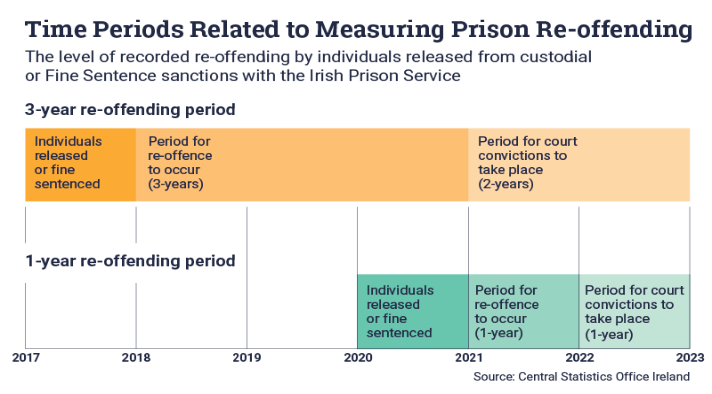These statistics are categorised as Under Reservation. This categorisation indicates that the quality of these statistics do not meet the standards required of official statistics published by the CSO. For further information please refer to the Statistics Under Reservation FAQs page.
Following a review of the Prison Re-offending Statistics an error was identified with the age group labels presented in the release. '51 years and over' was incorrectly labelled as '50 years and over'. This labelling error did not affect the data.
As of 11 September 2025 all labels and text have been corrected. More details on these updates are available in an Information Note. We apologise for any inconvenience this may have caused.
Over six in ten individuals (61%) who were released from custodial sentences during 2017 were convicted of re-offending within three years of release.
Re-offending tends to decline with age. While 84% of young adults re-offended within three years of being released, just over one quarter (27%) of those aged over 51 re-offended in the same period.
Individuals linked to custodial sentences relating to Public Order offences (78%) or Burglary offences (78%) were the most likely to re-offend within three years of release.
One-year re-offending rates for individuals released in 2020 indicate that 41% re-offended within a year after being released from custody.
Around half (48%) of the re-offending that was committed by individuals released in 2020 was linked to just two of the 16 offence categories (Public Order or Theft Related offences).
Individuals who indicated they were living in Westmeath (60%) and Cavan (53%) at the time of their release had the highest one-year re-offending rate while those living in Wexford, Sligo, and Donegal (23%) had the lowest tendency to re-offend.
The Prison Re-offending Statistics publication provides information on the level of recorded re-offending by individuals released from custodial or Fine Sentence1 sanctions with the Irish Prison Service. The re-offending rates are calculated as the percentage of individuals who have been convicted of any crime incident during the reference period after their release. This publication primarily provides re-offending estimates of individuals who were released from custody in 2017 (three year re-offending). In addition, more timely estimates for individuals released in 2020 (one year re-offending) are provided. For the three year re-offending estimates, a period of three years with a further two years for conviction after release is used to measure a re-offending incident and for the statistics on one year re-offending, a period of one year after release with a further year for conviction is used as the re-offending period. In addition to updates to existing re-offending estimates, this publication also provides estimates that show the levels of re-offending that exist regionally, based on where individuals registered as living at the time of their release.

1Footnote: Fine sentences are conditional custodial sentences in which custody is avoided when a fine is paid to the court by the convicted offender.
Learn about our data and confidentiality safeguards, and the steps we take to produce statistics that can be trusted by all.
Statistician's Comment
Commenting on the release, Felix Coleman, Statistician in the Crime and Criminal Justice Division, said: "Today’s publication provides annual estimates of the re-offending rates for individuals released from custody up to and including 2020. Additional insights are also provided in relation to the age, sex, offence, and re-offence types of those who re-offended. The most recent reference year available for statistics relating to one-year re-offending is 2020 because a minimum of two years is needed to establish a re-offending rate: one year for potential re-offences to take place, and one further year for court conviction proceedings to be completed.
National re-offending rates
Overall, both the three- and one-year re-offending estimates indicate a decline in the re-offending rate of individuals released from custody during the last decade. Statistics for 2020 indicate the one-year re-offending rate (41%) was 13 percentage points lower than the same measure for 2011 (54%). The one-year re-offending rate for 2020 was also the lowest measured since the first estimates of custodial re-offending were calculated for reference year 2011. The longer term re-offending rate measuring re-offending three years following release also shows a decline in the levels of re-offending. Between 2011 (68%) and the most recent year this analysis is available for (2017) the proportion of individuals released from custody who were convicted of a re-offence within three years (61%) also dropped.
Factors relating to re-offending
Offence type
Since 2017, statistics indicate that the reduction in custodial re-offending has been mainly due to reductions in the re-offending of individuals who received custodial sanctions for offences relating to Burglary (66% in 2017 down to 54% in 2020) or Damage to Property & the Environment (65% in 2017 down to 53% in 2020). In contrast, the re-offending rates of individuals who were released from custodial sentences related to Road & Traffic related incidents (37% in 2017) has reduced by just three percentage points during the same period (34% in 2020).
Age
The highest levels of re-offending from individuals who were released from custody in 2020 was among young adults. Six out of ten (60%) of young adults under the age of 21 re-offended within a year. In contrast, less than one third (32%) of 41-50 year olds re-offended in the same period following release.
Geographical region
There were significant regional differences in re-offending rates ranging from a third (30%) in the Mid-East, consisting of Kildare, Louth, Meath, and Wicklow to half (50%) in the South-West regions (consisting of Cork and Kerry). At county level the most recent statistics show that individuals who indicated they were living in Westmeath (60%) and Cavan (53%) at the time of their release had the highest one-year re-offending rate while those living in Wexford, Sligo and Donegal (23%) had the lowest tendency to re-offend."